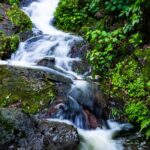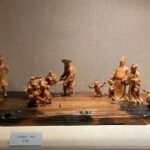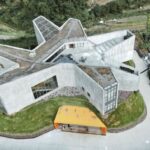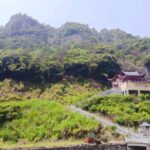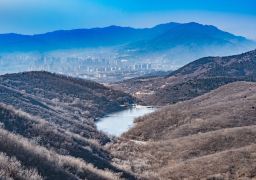Upon entering the gate of the Great Buddha Temple, one’s view suddenly opens up to reveal two Fangsheng ponds of different sizes, connected by a long causeway. The ancient trees along the pond’s edge sway gently, reflecting the light of the sky and the shadows of clouds. The clear waters of the two ponds, accompanied by the melodious chirping of orioles, create an atmosphere that is truly refreshing and uplifting.
The larger pond covers an area of 11,500 square meters and holds 28,950 cubic meters of water; the smaller pond is 2,800 square meters and contains 8,400 cubic meters of water. Leaning against the rock wall to the west of the larger pond, the words ‘Fangsheng Pond’ are carved, each character measuring 22.5 square meters, with a strong and vigorous calligraphy style, adding to the scenery. On the rock wall of Shiguping, there are three cliff inscriptions: ‘Namo Amitabha Buddha’, ‘Mahasthamaprapta Bodhisattva’, and ‘Avalokitesvara Bodhisattva’, which are the titles of the Western Three Saints. In the Buddhist hall, these three figures are enshrined together and called the Hall of Three Saints. Unobstructed and under the open sky, these inscriptions, like statues, inspire reverence and are thus also known as the ‘Open-air Great Hall’. Historical Background: The Fangsheng Pond was originally a low-lying area with two water-collecting basins. Springs from the east side of the Stone City Valley, namely Yutangwan and Luohanwan, flow down and accumulate into a small pond along the base of the mountain beside the Great Buddha; springs from the south side of the Stone City Valley, Huarenwan and Shimenkan, flow down and accumulate into the larger pond. During the late Qing Dynasty, in the Guangxu era, Master Baoguang dredged the Jiaxitongxiang and built retaining walls, transforming it into the Fangsheng Pond, which is a religious facility of the temple, specifically for the faithful to release fish and shrimp, practicing good deeds. Buddhism advocates the protection of all living beings with the principle of ‘equality of all beings’. The one who advocated for the release of life and established a system was Master Zhi. The Fangsheng Pond was built in front of Master Zhi’s tomb tower. In 1932, the Fangsheng Pond had become shallow and was subject to theft, so it was led by the lay Buddhist Ma Qici to raise funds for its reconstruction. After 1979, with the gradual implementation of religious policies, the Fangsheng Pond was dredged, embanked, and restocked with fish once again. Opening Hours: From May 1st to September 30th, open from 06:00 to 17:30; from October 1st to April 30th, open from 06:00 to 17:00.Fangsheng Pond
Upon entering the gate of the Great Buddha Temple, one’s view suddenly opens up to reveal two [...]


